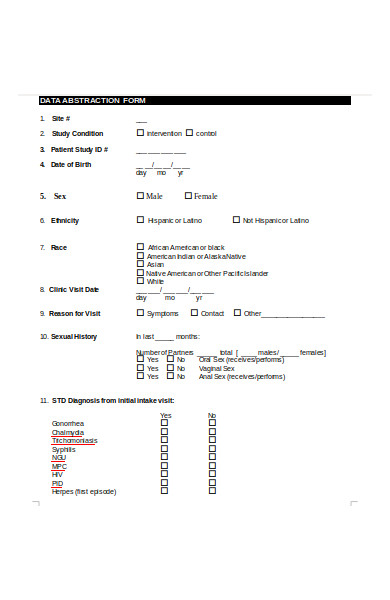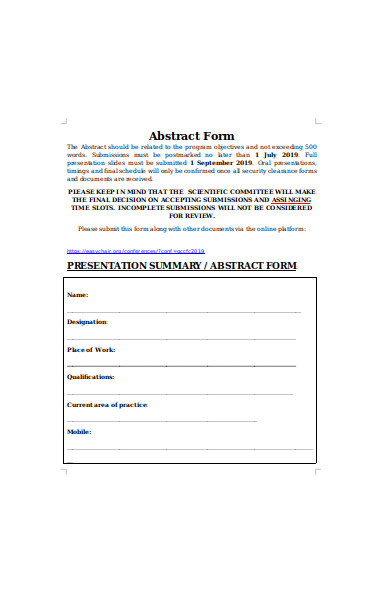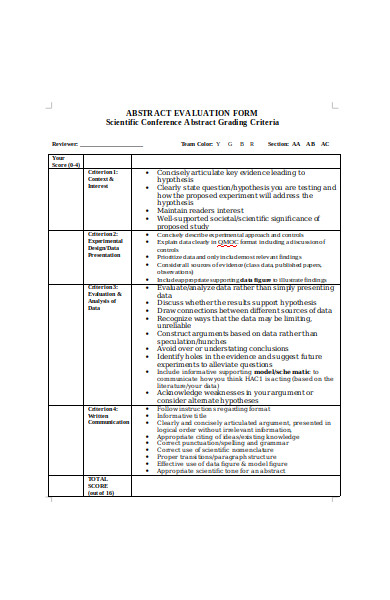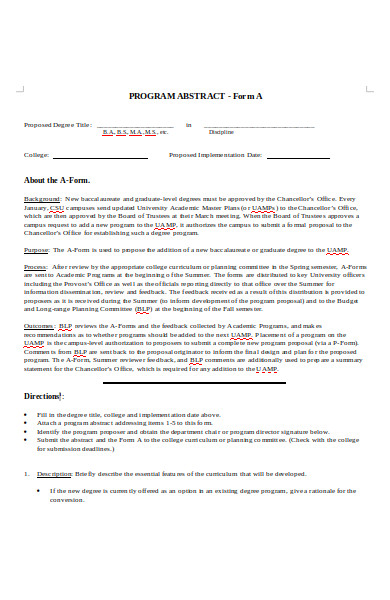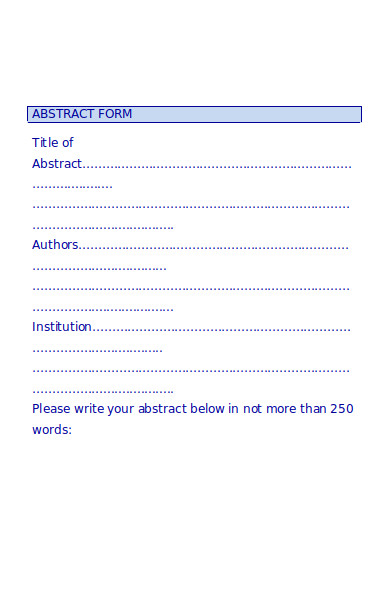Sergio Marquina or the Professor in Netflix Originals series “Money Heist” spent twenty-four hours inside the hospital during his childhood days. His skin barely touches daylight and his eyes grow tired of seeing only white. But his mind keeps spiraling as he plans the most formidable heist in history. Although he was aware of the consequences and possibilities of being caught, his ideas made him organize the backbone of his perfect plan. This feeling is mutual to abstract forms.
From academic studies to medical records down to individual projects, abstract forms make sense of a large volume of data into big chunks of categorized information to achieve an outlined view of the purpose or findings from a document. It acts like a blueprint that can give any reader a quick analysis without going through the whole document wasting precious time.
What Is an Abstract Form?
Abstract Form is a summary of any research article, journal, speech, medical history, review or any in-depth investigation document that is deemed important to anyone who wants to access the data and its relevance. It is written in a paragraph ranging from 500 to 100 words or a list of fields like those of a registration form where you can either fill in on a blank or put checkmarks for a given set of options. Moreover, it gives anyone the ability to analyze efficiently the owner of the document, date published and information of its contents.
FREE 52+ Abstract Forms in PDF | MS Word | Excel
1. Driver Abstract Request Form
2. Clinical Abstract Application Form
3. Lower Fair Abstract Form in PDF
4. University Abstract Form Sample
5. Official Abstract and Certification Form
6. Abstract Art Submission Form
7. Accreditation Abstract Form Sample
8. Medical Record Abstract Form
9. Aggregate Abstract Form in PDF
10. Bid Abstract Form Sample
11. Speakers Abstract Submission Form
12. Agriculture Lease Abstract Form
13. Project Abstract Form
14. Abstract Review Scoring Form
15. Abstract Request Judgement Form
16. Author Abstract Form
17. Abstract Account Declaration Form
18. Standard Abstract Form
19. Driver Abstract Statement of Intent Form
20. Abstract Acknowledgement Form
21. University Abstract Submission Form
22. Conference Abstract Form
23. Data Abstract Form
24. Abstract Receipt Form
25. Poster Abstract Form
26. Dental Student Abstract Form
27. Abstract of Thesis Form
28. Abstract Application Form
29. Cardiac Abstract Form
30. Nursing Abstract Form
31. Research Forum Abstract Form
32. Document & Loan History Abstract Form
33. Abstraction & Impoundments Form
34. Abstract Registration Form
35. University Abstract Form
36. Presentation Abstract Form
37. Abstract Evaluation Form
38. Research Event Abstract Form
39. College Abstract Form
40. Foreclosure Abstract Long Form
41. Public Health Abstract Form
42. Pathologists Abstract Form
43. Scientific Meeting Abstract Form
44. Program Abstract Form
45. Audit Competition Abstract Form
46. Student Abstract Form
47. Local Competition Abstract Form in MS Word
48. Diabetes Abstract Form Sample
49. Hotel Abstract Submission Form
50. No Preference Abstract Form
51. Company Abstract Form
52. Lease Abstract Form
53. Basic Abstract Form
Different Types of an Abstract Form
An abstract form can be tailored to fit various documents. In that case, it has been narrowed down to three types sorting out which works best for a certain purpose. Each type has elements that make it reasonable to craft that form in that specific way. Here are detailed explanations on how each type is formatted:
-
Informative Abstract
The Professor was able to impart the different parts of the plan to his accomplices because he presented it in a way much like an informative abstract does. He gives the possible actions of the police and the actions necessary for them to take control of the situation. Ideally, it works with informative abstracts such that the highlighted components must include the key parts and the conclusion. It is lengthy that has a word reach of more than 200 words to more than one page. The details are freely expounded as long as it answers the following questions:
a. What is the purpose?
b. What are the essential steps?
c. What information are closely linked to the data?
d. What is the (expected) output?
e. What are the conclusion and the possible aspects to be improved?
Examples of this type include university abstract form, project abstract form, and author abstract form. However, one should keep in mind that the informative abstract does not generate new ideas but rather gathers the important parts altogether into one avenue.
-
Descriptive Abstract
In the same series, Raquel Murillo and the police used negotiation techniques to ensure the safety of the hostages. This technique mainly focuses on the purpose and the ways to avoid killing a hostage. Definitely, a descriptive abstract also exhibits the same elements. It can have less than 100 words that encompass the objectives or purpose, the methods, and the general category that any document belongs to. This type highlights keywords, but it doesn’t provide conclusions or recommendations. Rather it uses checkboxes or field data types instead of the lengthy paragraph structure of an informative abstract. Examples of this type include agriculture lease abstract form, abstract request judgment form, document and loan history abstract form, and much more. This type commonly applies to medical documents, lawsuits, and project requests.
-
Critical Abstract
The people watching the heist broadcasted on their TVs while the negotiations were going on represented what a critical abstract does. The people criticized how the police acted and showed some support towards the Professor’s gang in the third season of the series. Just like this scenario, a critical abstract employs the same attitude towards its elements. It is similar to an informative abstract, but, in addition to that, it may give comments to the data’s findings, methods, and credibility. This type is not common. An example would be the abstract evaluation form.
The Science Behind Writing Abstracts: Why is it hard to write one?
Come to think of it. Writing a handful of pages for the discussion of results in a research paper is three times easier than actually writing a one-page abstract form. Why is it hard to write one? Science explains.
Advances in technology enabled us to generate an enormous amount of energy using fuel that does not release harmful pollutants. This technology, known to many as nuclear power plants, can produce 1 megawatt with just one gram of fuel called uranium. Whereas in coal-fired power plants, it needs 3 tons of coal to produce the same energy. What’s in this magic fuel capable of such ability? Simple. It is a product of a tedious process similar to extracting syrup from sap. On average, it takes 45 liters of sap to produce a liter of maple syrup. Similarly, the uranium fuel used in nuclear reactors is only 0.7% from its source. Upon extraction from the source, it still has to undergo a process of enrichment to make it useful in this reactor. It takes a lot of hardwork, right?
The fuel is powerful because it went through careful extraction requiring energy and time, just like your abstract form. It can even take hours or a day to formulate the abstract form. Making sense in a large volume of data enclosed in a document can be exhausting; there are ways to eliminate the extra load. Read through the steps in creating abstract forms and be more efficient in extracting the essential information from any document.
How to Create an Abstract Form
As mentioned earlier, it is absolutely not easy to make an abstract form. Even if it is difficult, it is not impossible to make things simpler. Here are the steps, along with some tricks that make you work more effectively.
Step 1: Read and Highlight
There are no shortcuts. Go through the whole data because this is the essential step in crafting your abstract form. While you read every paragraph, jot down essential information from each and construct them into sentences. After reading one section, check if the section description matches the constructed sentences from each paragraph. Then, describe the section along with the important parts in one sentence if applicable. In this way, it will be easier for you to go back without reading the whole section again. In the case of legal forms, while you fast check a report, jot down notes.
Step 2: Identify the Purpose of the Abstract Form
The trick in any writing journey is to always begin with the why. Evaluate the data and its purpose to exist in the first place. Try to think about how the abstract form will help anyone who wants access to the data in your document. At the same time, determine which type works best. Once you have these in mind or a scratch paper, browse through our templates for reference.
Step 3: Draft your own or Customize our Templates
Do the dirty work of drafting. Review your notes from the first step because it helps in weaving the paragraph explaining a research paper, thesis or book. In other documents such as reports, your notes can help you sort the details to include in the abstract form such as contact details, special restrictions or requests, and dates of importance. If you prefer to customize our professionally-crafted templates, it will only take you an hour or less to suit the template to your needs.
Step 4: Details are Important
An abstract form can say so much with lesser words. It is important to double-check the details included in your abstract form. Try acting as if you know nothing about the document and review it. Are the important details already necessary for someone to understand the contents of your paper or report? Delete some parts if something seems awkward in the form. Also, use a clean format, especially in using the appropriate font or font size and checking the indent of the text and text boxes.
Terminologies
Document– is any written or printed proof or basis that contains a handful or information such as demographic information, statistical data, findings, and analysis.
Abstract- is a written backbone of any document that can have paragraphs or simply, fill in details that helps any person evaluate a document’s relevance without actually reading the whole paper or report.
Report– is the written records of a legal document such as clinical records, purchase records, law-related files and etc. It follows the descriptive type of abstract forms.
Paper– is the written output of research proposal, thesis, or any academic journals involving literature reviews. It follows the informative type of abstract forms.
FAQs
1. What are the elements in an abstract form?
In general, the elements are the purpose or objectives, methods used, scope of the document, conclusion, recommendations, and specific details such as the name of the owner of the document. However, some elements may not apply to some documents because an abstract form is flexible in its format, depending on its purpose.
2. Why an abstract form important?
Aside from the fact that an abstract form is sometimes a requirement, it makes your document easily readable. Without dwelling on the pages of information, a person requesting your document already has a bird’s eye view. Also, some titles are misleading. With the aid of an abstract form, it becomes easier to relay the essence of the document.
The perfect plan does not exist. But a good plan does work when a careful analysis of important concepts and possible implications becomes part of the planning phase. The same principle applies to create an abstract form.
Related Posts
-
FREE 50+ Letter Forms in PDF | MS Word
-
FREE 32+ Holiday Forms in PDF | MS Word
-
FREE 30+ Nonprofit Forms in PDF | MS Word
-
FREE 31+ Therapy Forms in PDF | MS Word | XLS
-
FREE 52+ Bid Forms in PDF | MS Word | XLS
-
FREE 32+ Communication Forms in PDF | MS Word | XLS
-
FREE 44+ E Commerce Forms in PDF | MS Word
-
FREE 30+ Animal Shelter Forms in PDF | MS Word
-
FREE 34+ Charity Forms in PDF | MS Word | Excel
-
FREE 35+ Advertising Forms in PDF | MS Word | XLS
-
FREE 53+ Sports Forms in PDF | MS Word | Excel
-
FREE 51+ Payment Forms in PDF | MS Word | Excel
-
FREE 52+ Subscription Forms in PDF | MS Word | Excel
-
FREE 50+ RSVP Forms in PDF | MS Word
-
FREE 50+ Recommendation Forms in PDF | MS Word























